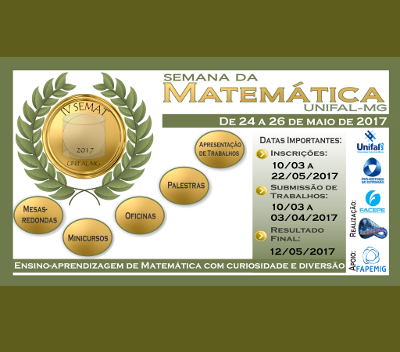Workshop
Soroban and teaching Mathematics for people with visual impairments
Keywords:
mathematics education, abacus, coursewareAbstract
References
BRASIL. Ministério da Educação. Lei de Diretrizes e Bases da Educação.
(1996) Lei no 9.394 de 20 de dezembro de 1996. Bras´ılia: MEC. Disponível em: http://www6.senado.gov.br/legislacao/ListaTextoIntegral.action?id=75723. Acesso em 09 nov. 11.
BRASIL. Ministério da Educação, Secretaria de Educação Especial. (2006) A construção do conceito de número e o pré-soroban. Brasília: MEC/SEESP.
BRASIL. Ministério da Educação, Secretaria de Educação Especial. (2008) Política Nacional de Educação Especial na Perspectiva da Educação Inclusiva. MEC/SEESP. Disponível em: http://portal.mec.gov.br/arquivos/pdf/politicaeducespecial.pdf. Acesso em: 26 nov. 11.
BRASIL. Ministério da Educação, Secretaria de Educação Especial. (2009) Soroban: manual de técnicas operatórias para pessoas com deficiência visual. Brasília: MEC/SEESP.
SOUZA, R. N. S. (2004) Soroban: Uma ferramenta para ajudar a pensar, contribuindo na inclusão de alunos portadores de necessidades visuais. In: ENCONTRO NACIONAL DE EDUCAÇÃO MATEMÁTICA, 8, 2004. Recife. Anais do VIII ENEM. Pernambuco: UFPE. 1-9. Disponível em: http://www.sbem.com.br/files/viii/pdf/03/MC84642289968.pdf.
Acesso em: 30 out. 11.
TEIXEIRA, R. A. G. (2006) O uso do Soroban como princípio lógico no ensino da Matemática. Universidade Federal de Goiás. Goiânia: FE/UFG. Disponível em: http://www.colegioglauciacosta.com.br/moodle/mod/resource/view.php?id=8. Acesso em: 10 nov. 11.
Downloads
Published
How to Cite
Issue
Section
License
Proposta de Política para Periódicos de Acesso Livre
Autores que publicam nesta revista concordam com os seguintes termos:
- Autores mantém os direitos autorais e concedem à revista o direito de primeira publicação, com o trabalho simultaneamente licenciado sob a Licença Creative Commons Attribution que permite o compartilhamento do trabalho com reconhecimento da autoria e publicação inicial nesta revista.
- Autores têm autorização para assumir contratos adicionais separadamente, para distribuição não-exclusiva da versão do trabalho publicada nesta revista (ex.: publicar em repositório institucional ou como capítulo de livro), com reconhecimento de autoria e publicação inicial nesta revista.
- Autores têm permissão e são estimulados a publicar e distribuir seu trabalho online (ex.: em repositórios institucionais ou na sua página pessoal) a qualquer ponto antes ou durante o processo editorial, já que isso pode gerar alterações produtivas, bem como aumentar o impacto e a citação do trabalho publicado (Veja O Efeito do Acesso Livre).

